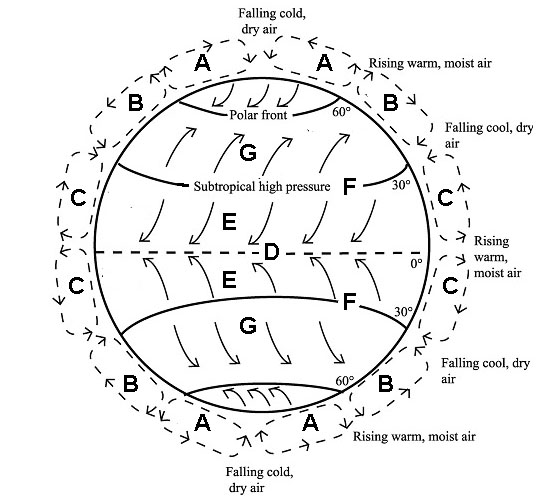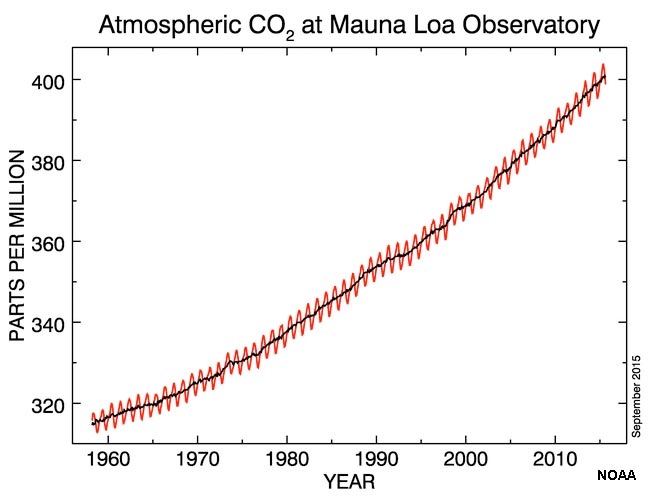1. Nearly 80 percent of the air’s mass and 99 percent of the water vapor in the air occurs within:
a. the stratosphere.
b. the troposphere.
c. the upper atmosphere.
d. outer space.
2. Incoming solar radiation involves all wavelengths of the electromagnetic spectrum. The atmosphere is transparent to most wavelengths, but part of the solar spectrum are absorbed by certain greenhouse gases in the atmosphere. Which of the following is NOT considered a greenhouse gas?
a. water vapor (H2O)
b. oxygen (O2)
c. carbon dioxide (CO2)
d. methane (CH4)
3. The amount of water vapor in the air can range from trace amounts up to about 4% by volume. Which of the following statements is NOT true?
a. Warm air can hold more moisture than cold air.
b. The amount water moisture that air can hold depends on factors including temperature, air pressure, and the amount and kinds of particulate matter dispersed in the air.
c. When air has reached the maximum amount or water it can hold it is called saturated.
d. Moist air is heavier than dry air.
4. At sea level, the pressure of the atmosphere:
a. averages 1013.25 millibars.
b. increases in pressure when stormy weather is taking place.
c. decreases in pressure when cold, clear air masses moves into an area.
d. never changes.
5. Of the 4 types of air listed below, which would be less dense and likely to rise the fastest?
a. Warm, dry air
b. Cool, dry air
c. Warm, moist air
d.
Cool, moist air
6. Regarding atmospheric pressure systems moving into a region:
a. surface winds blow from high to low pressure.
b. high pressure systems have dry conditions with sinking air masses.
c. low pressure systems have wetter conditions with rising air masses.
d. All the choices are correct.
7. Hurricanes can form in association with which type of air mass?
a. polar-maritime air mass
b. temperate-continental air mass
c. tropical-maritime air mass
d. warm air sinks, forming clouds, resulting in rain
8. Tiny (very microscopic) dust particles and aerosols can become cloud condensation nuclei (CCNs). CCNs come from many sources: dust storms, fires, volcanoes, sea spray, plants, and pollution. If there are too many CCNs in the air, what happens?
a. It rains more intensely.
b. Smog turns to fog.
c. Rain droplets (or ice crystals) don’t get big enough to fall as rain (or snow).
d. All of the choices are correct.
9. The fog often called the marine layer in coastal California is generally most often what kind of cloud?
a. Cirro-form
b. Cumulo-form
c. Nimbo-form
d. Strato-form
10. Sound travels at about 1,088 feet per second. You just saw a flash of sky-to-ground lightning and you counted seven second before you heard the thunder. About how far away was the lightning strike?
a. 0.6 miles.
b. 1.0 miles.
c. 1.4 miles.
d. 2.2 miles.
11. The Coriolis effect is caused by the rotation of the Earth. As a result:
a. low pressure systems (like hurricanes) turn counter-clockwise in the Northern Hemisphere.
b. high pressure systems turn clockwise in the Southern Hemisphere.
c. maximum Coriolis effect is at the equator and does not occur at the poles.
d. all of choices are correct.
12. Gray sky weather is far too common in parts of the Midwest and Northeastern United States. Sometimes it can last for days. What is the likely cause?
a. a fast-moving cold front
b. a cold air mass moving over a warm air mass
c. a slow-moving or stalled warm front
d. a slow-moving or stalled cold front
13.
The amount of energy Earth receives from the Sun is not evenly distributed. Which of the following statements is most correct?
a. The equatorial regions are warmer than the poles because direct sunlight is concentrated and little is reflected.
b. In polar regions, light strikes the earth at an angle; it is diffuse and much of it is reflected back into space.
c. The seasonal variations (winter and summer) also affect the distribution of heating of the planet.
d. all the choices are correct.
14. The Coriolis effect influences all moving objects, especially ones moving over large distances (such as intercontinental ballistic missiles). How does the Coriolis effect causes objects or moving masses of air or ocean currents?
a. It causes them to change direction—not speed.
b. The maximum Coriolis effect occurs at poles.
c. No Coriolis effect occurs at the equator.
d. All choices are correct.
Questions 15-18 refer to the Global Atmospheric Circulation diagram below.

The polar circulation cells (60° to 90° N and S) are shown as letters “A.” The Ferrel circulation cells (30° to 60° N and S of equator) are letters “B,” and the Hadley circulation cells (0° to 30° N and S of equator) are letters “C.”
15. Which letter represents the Inter-tropical convergence zone (ITCZ)?
16. Doldrums, where sailing ships can be trapped without winds for extended periods of time, are most common in the zone represented by which letter?
17. The NE and SE Trade Winds are represented by which letter?
18. The zone of potentially dangerous winds of the horse latitudes are represented by which letter?
19. A tropical cyclone is caused by spinning air currents associated with a low pressure system. A tropical storm becomes a cyclone (or a hurricane or a typhoon) when:
a. tropical depressions move north across the equator.
b. average wind speeds in the heart of the storm rise above 38 mph.
c. average wind speeds in the heart of the storm rise above 74 mph.
d. average wind speeds in the heart of the storm rise above 155 mph.
20. The figure below shows the record of changing carbon-dioxide concentrations in the atmosphere as recorded by NOAA at it’s atmospheric research lab on Mauna Loa in Hawaii.

The graph shows that:
a. carbon-dioxide concentrations have been steadily increasing for the last 50 years.
b. seasonal growth and decay of plant leaves in the northern hemisphere cause minor but measurable fluctuations in carbon-dioxide concentrations.
c. carbon-dioxide created by the burning of fossil fuels and other sources is being produced faster than the oceans can absorb and consume the gases.
d. all the choices are correct.
|


